warning light Peugeot 508 2011 Owner's Manual - RHD (UK, Australia)
[x] Cancel search | Manufacturer: PEUGEOT, Model Year: 2011, Model line: 508, Model: Peugeot 508 2011Pages: 340, PDF Size: 25.76 MB
Page 4 of 340
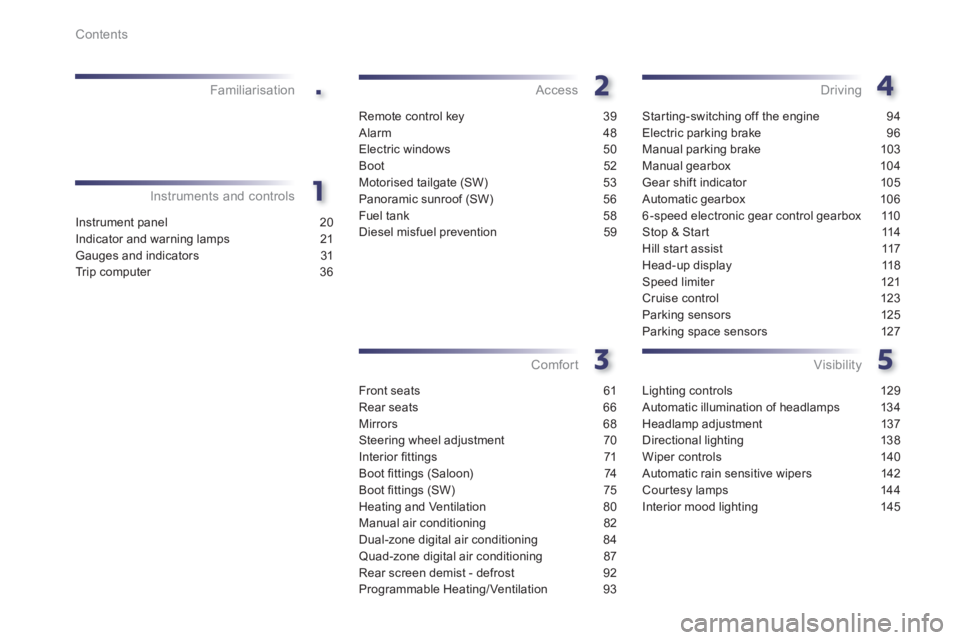
.
Contents
Instrument panel 20
Indicator and warning lamps 21
Gauges and indicators 31
Tr i p c o m p u t e r 3 6
Instruments and controlsFamiliarisation
Remote control key 39
Alarm 48
Electric windows 50
Boot 52
Motorised tailgate (SW) 53
Panoramic sunroof (SW) 56
Fuel tank 58
Diesel misfuel prevention 59
Access
Front seats 61
Rear seats 66
Mirrors 68
Steering wheel adjustment 70
Interior fi ttings 71
Boot fi ttings (Saloon) 74
Boot fi ttings (SW) 75
Heating and Ventilation 80
Manual air conditioning 82
Dual-zone digital air conditioning 84
Quad-zone digital air conditioning 87
Rear screen demist - defrost 92
Programmable Heating/ Ventilation 93
Comfort
Star ting-switching off the engine 94
Electric parking brake 96
Manual parking brake 103
Manual gearbox 104
Gear shift indicator 105
Automatic gearbox 106
6 -speed electronic gear control gearbox 110
Stop & Start 114
Hill start assist 117
Head-up display 118
Speed limiter 121
Cruise control 123
Parking sensors 125
Parking space sensors 127
Driving
Lighting controls 129
Automatic illumination of headlamps 134
Headlamp adjustment 137
Directional lighting 138
Wiper controls 140
Automatic rain sensitive wipers 142
Cour tesy lamps 144
Interior mood lighting 145
Visibility
Page 10 of 340
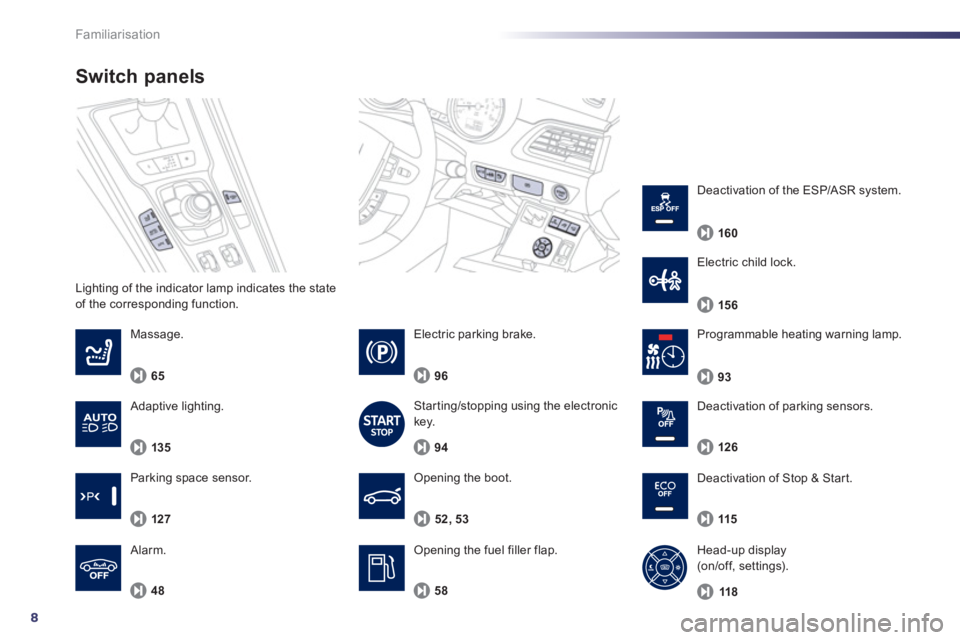
8
Familiarisation
Lighting of the indicator lamp indicates the state
of the corresponding function.
Switch panels
Opening the boot.
Opening the fuel filler flap.
52, 53
Massage.
65
48
Alarm.
Programmable heating warning lamp.
58
93
Electric parking brake.
96
Star ting/stopping using the electronic
key.
94
Deactivation of Stop & Start.
115
Head-up display
(on /of f, set tings).
118
Deactivation of parking sensors.
126
Parking space sensor.
127
Electric child lock.
15 6
Deactivation of the ESP/ASR system.
160
Adaptive lighting.
135
Page 12 of 340
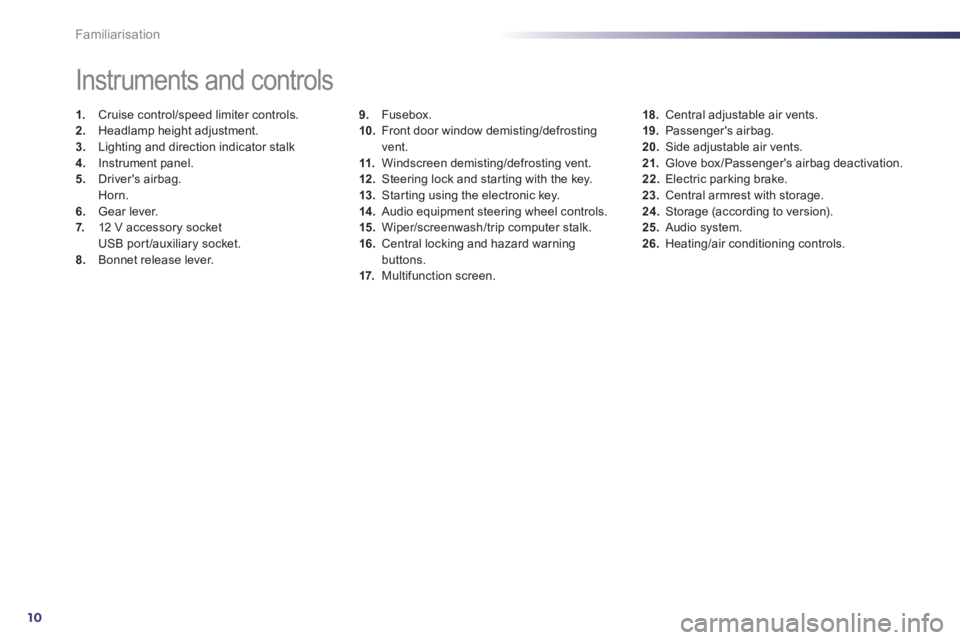
10
Familiarisation
9.
Fusebox.
10.
Front door window demisting/defrosting
vent.
11.
Windscreen demisting/defrosting vent.
12 .
Steering lock and star ting with the key.
13.
Star ting using the electronic key.
14 .
Audio equipment steering wheel controls.
15.
Wiper/screenwash/trip computer stalk.
16.
Central locking and hazard warning
buttons.
17.
Multifunction screen.
Instruments and controls
1.
Cruise control/speed limiter controls.
2.
Headlamp height adjustment.
3.
Lighting and direction indicator stalk
4.
Instrument panel.
5.
Driver's airbag.
Horn.
6.
Gear lever.
7.
12 V accessory socket
USB port /auxiliary socket.
8.
Bonnet release lever.
18.
Central adjustable air vents.
19.
Passenger's airbag.
20.
Side adjustable air vents.
21.
Glove box /Passenger's airbag deactivation.
22.
Electric parking brake.
23.
Central armrest with storage.
24.
Storage (according to version).
25.
Audio system.
26.
Heating/air conditioning controls.
Page 23 of 340
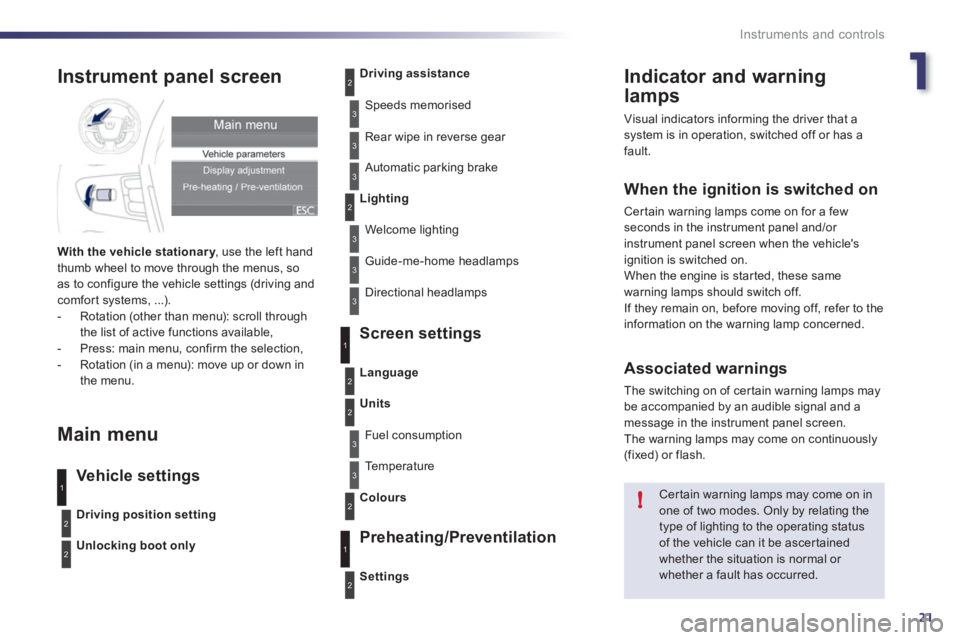
1
21
!
Instruments and controls
Indicator and warning
lamps
Visual indicators informing the driver that a
system is in operation, switched off or has a
fault.
When the ignition is switched on
Cer tain warning lamps come on for a few
seconds in the instrument panel and/or
instrument panel screen when the vehicle's
ignition is switched on.
When the engine is started, these same
warning lamps should switch off.
If they remain on, before moving off, refer to the
information on the warning lamp concerned.
Associated warnings
The switching on of cer tain warning lamps may
be accompanied by an audible signal and a
message in the instrument panel screen.
The warning lamps may come on continuously
(fixed) or flash.
Cer tain warning lamps may come on in
one of two modes. Only by relating the
type of lighting to the operating status
of the vehicle can it be ascer tained
whether the situation is normal or
whether a fault has occurred.
1
2
2
2
3
3
3
2
3
3
Instrument panel screen
With the vehicle stationar y
, use the left hand
thumb wheel to move through the menus, so
as to configure the vehicle settings (driving and
comfort systems, ...).
- Rotation (other than menu): scroll through
the list of active functions available,
- Press: main menu, confirm the selection,
- Rotation (in a menu): move up or down in
the menu.
Main menu
Vehicle settings
Screen settings
Preheating/Preventilation
Driving position setting
Unlocking boot only
Driving assistance
Speeds memorised
Rear wipe in reverse gear
Automatic parking brake
Lighting
Welcome lighting
Guide-me-home headlamps
Directional headlamps
Settings
Language
Units
Fuel consumption
Te m p e r a t u r e
Colours
3
1
2
2
3
2
3
1
2
Page 24 of 340
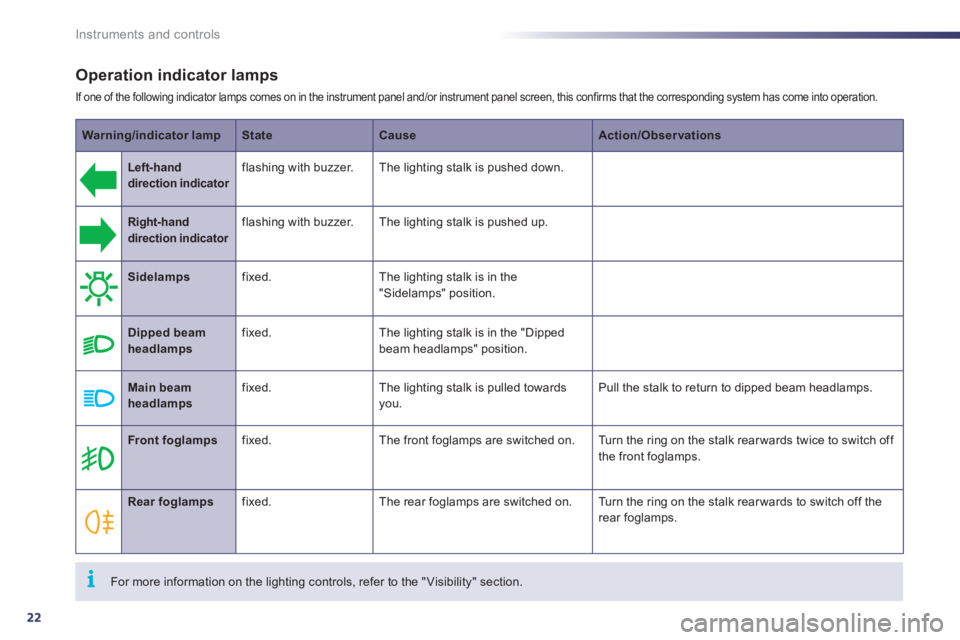
22
i
Instruments and controls
Operation indicator lamps
If one of the following indicator lamps comes on in the instrument panel and/or instrument panel screen, this confirms that the corresponding system has come into operation.
Warning/indicator lamp
State
Cause
Action/Observations
Left-hand
direction indicato
r
flashing with buzzer. The lighting stalk is pushed down.
Right-hand
direction indicator
flashing with buzzer. The lighting stalk is pushed up.
Sidelamps
fixed. The lighting stalk is in the
"Sidelamps" position.
Dipped beam
headlamps
fixed. The lighting stalk is in the "Dipped
beam headlamps" position.
Main beam
headlamps
fixed. The lighting stalk is pulled towards
you. Pull the stalk to return to dipped beam headlamps.
Front foglamps
fixed. The front foglamps are switched on. Turn the ring on the stalk rear wards twice to switch off
the front foglamps.
Rear foglamps
fixed. The rear foglamps are switched on. Turn the ring on the stalk rear wards to switch off the
rear foglamps.
For more information on the lighting controls, refer to the "Visibility" section.
Page 26 of 340
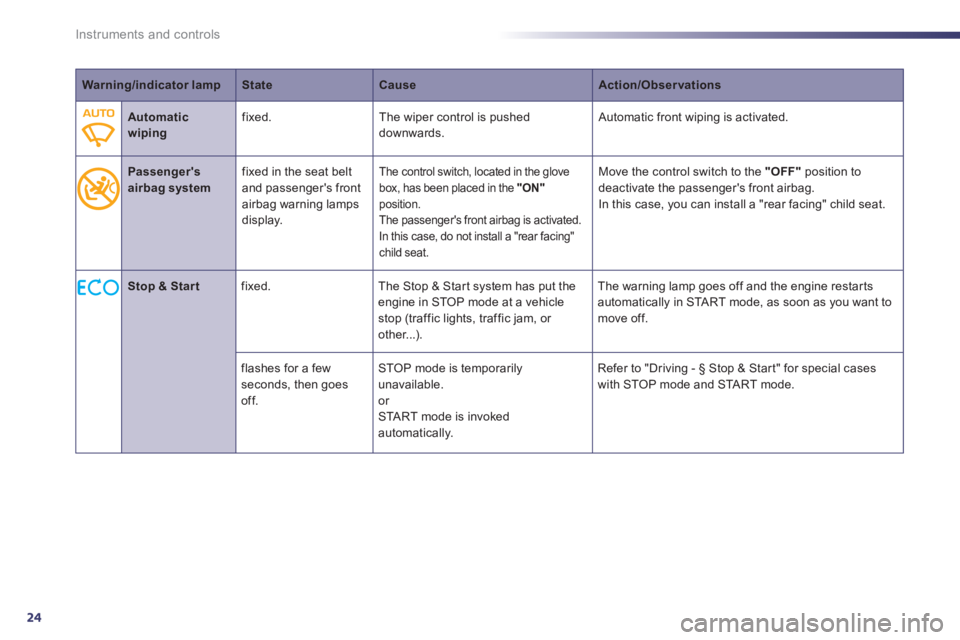
24
Instruments and controls
Warning/indicator lamp
State
Cause
Action/Observations
Automatic
wiping
fixed. The wiper control is pushed
downwards. Automatic front wiping is activated.
Passenger's
airbag system
fixed in the seat belt
and passenger's front
airbag warning lamps
display.
The control switch, located in the glove
box, has been placed in the "ON"
position.
The passenger's front airbag is activated.
In this case, do not install a "rear facing"
child seat. Move the control switch to the "OFF"
position to
deactivate the passenger's front airbag.
In this case, you can install a "rear facing" child seat.
Stop & Start
fixed. The Stop & Star t system has put the
engine in STOP mode at a vehicle
stop (traffic lights, traffic jam, or
other...). The warning lamp goes off and the engine restar ts
automatically in START mode, as soon as you want to
move off.
flashes for a few
seconds, then goes
off. STOP mode is temporarily
unavailable.
or
START mode is invoked
automatically. Refer to "Driving - § Stop & Start" for special cases
with STOP mode and START mode.
Page 34 of 340
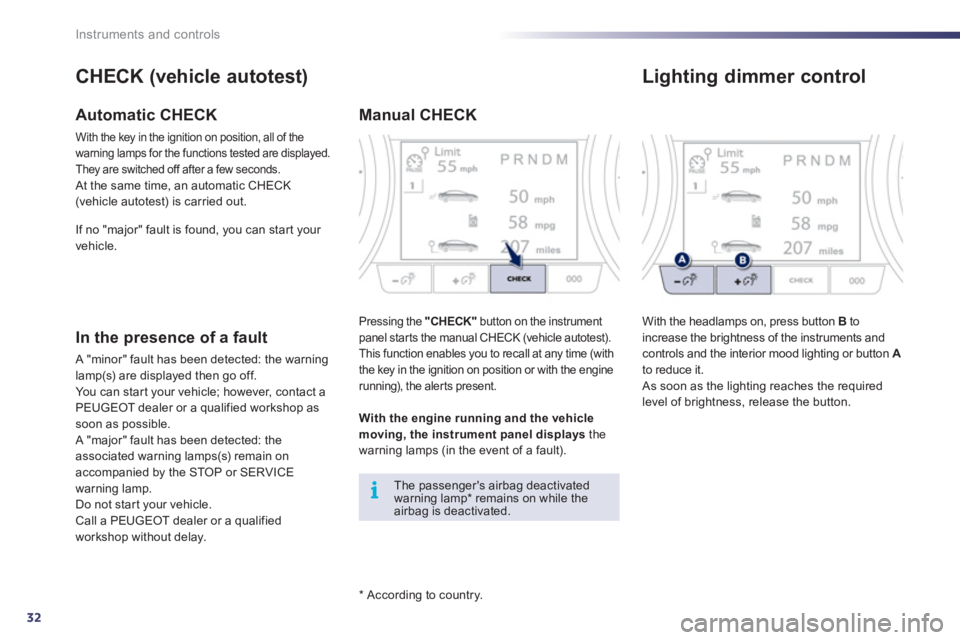
32
i
Instruments and controls
* According to country.
CHECK (vehicle autotest)
Automatic CHECK
With the key in the ignition on position, all of the
warning lamps for the functions tested are displayed.
They are switched off after a few seconds.
At the same time, an automatic CHECK
(vehicle autotest) is carried out.
In the presence of a fault
A "minor" fault has been detected: the warning
lamp(s) are displayed then go off.
You can start your vehicle; however, contact a
PEUGEOT dealer or a qualified workshop as
soon as possible.
A "major" fault has been detected: the
associated warning lamps(s) remain on
accompanied by the STOP or SERVICE
warning lamp.
Do not start your vehicle.
Call a PEUGEOT dealer or a qualified
workshop without delay.
Manual CHECK
Pressing the "CHECK
"
button on the instrument
panel star ts the manual CHECK (vehicle autotest).
This function enables you to recall at any time (with
the key in the ignition on position or with the engine
running), the aler ts present.
The passenger's airbag deactivated
warning lamp * remains on while the
airbag is deactivated.
With the engine running and the vehicle
moving, the instrument panel displays
the
warning lamps (in the event of a fault). If no "major" fault is found, you can start your
vehicle.
Lighting dimmer control
With the headlamps on, press button B
to
increase the brightness of the instruments and
controls and the interior mood lighting or button A
to reduce it.
As soon as the lighting reaches the required
level of brightness, release the button.
Page 79 of 340
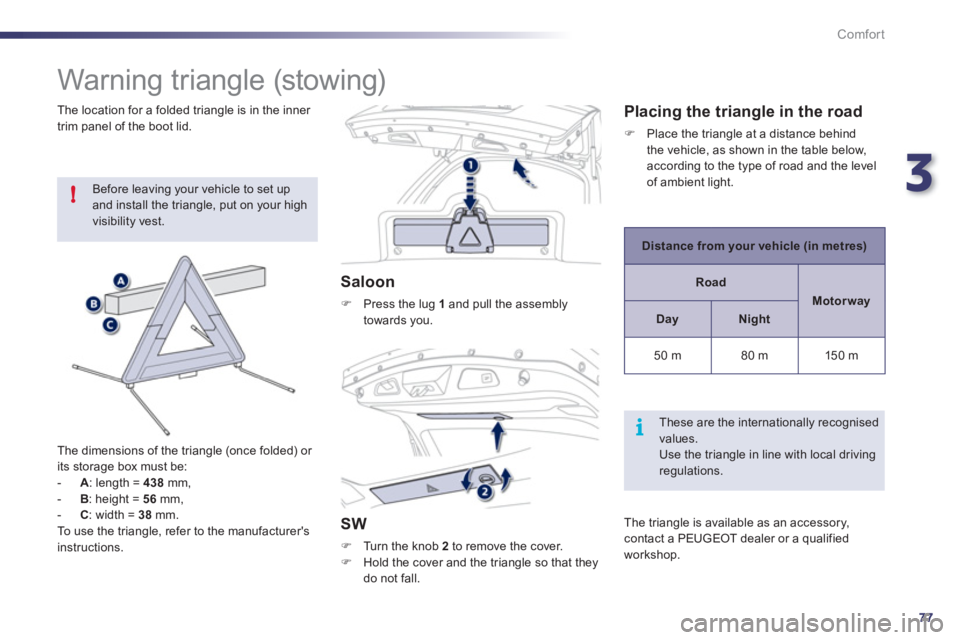
3
77
!
i
Comfort
Warning triangle (stowing)
Before leaving your vehicle to set up
and install the triangle, put on your high
visibility vest.
The dimensions of the triangle (once folded) or
its storage box must be:
- A
: length = 438
mm,
- B
: height = 56
mm,
- C
: width = 38
mm.
To use the triangle, refer to the manufacturer's
instructions.
Saloon
�)
Press the lug 1
and pull the assembly
towards you.
SW
�)
Turn the knob 2
to remove the cover.
�)
Hold the cover and the triangle so that they
do not fall.
The location for a folded triangle is in the inner
trim panel of the boot lid.
Placing the triangle in the road
�)
Place the triangle at a distance behind
the vehicle, as shown in the table below,
according to the type of road and the level
of ambient light.
Distance from your vehicle (in metres)
Road
Motorway
Day
Night
50 m
80 m
150 m
These are the internationally recognised
values.
Use the triangle in line with local driving
regulations.
The triangle is available as an accessory,
contact a PEUGEOT dealer or a qualified
workshop.
Page 96 of 340
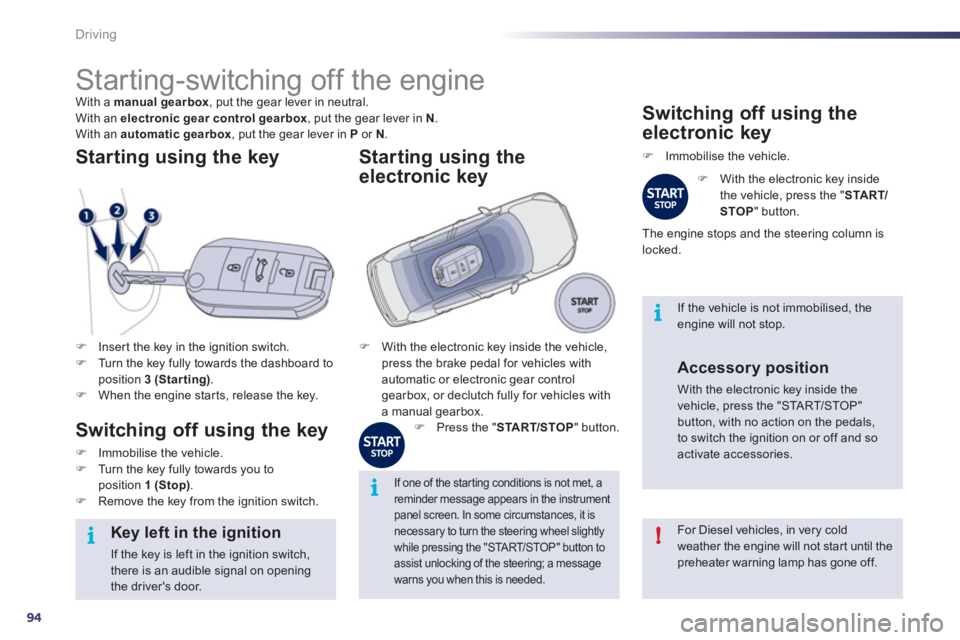
94
i
!
i
i
Driving
Starting-switching off the engine
With a manual gearbox
, put the gear lever in neutral.
With an electronic gear control gearbox
, put the gear lever in N
.
With an automatic gearbox
, put the gear lever in P
or N
.
�)
Inser t the key in the ignition switch.
�)
Turn the key fully towards the dashboard to
position 3 (Star ting)
.
�)
When the engine star ts, release the key.
Starting using the key
Switching off using the key
�)
Immobilise the vehicle.
�)
Turn the key fully towards you to
position 1 (Stop)
.
�)
Remove the key from the ignition switch.
For Diesel vehicles, in very cold
weather the engine will not start until the
preheater warning lamp has gone off.
Key left in the ignition
If the key is left in the ignition switch,
there is an audible signal on opening
the driver's door.
If one of the star ting conditions is not met, a
reminder message appears in the instrument
panel screen. In some circumstances, it is
necessary to turn the steering wheel slightly
while pressing the "START/STOP" button to
assist unlocking of the steering; a message
warns you when this is needed.
If the vehicle is not immobilised, the
engine will not stop.
�)
With the electronic key inside the vehicle,
press the brake pedal for vehicles with
automatic or electronic gear control
gearbox, or declutch fully for vehicles with
a manual gearbox.
Starting using the
electronic key
�)
Press the " START/STOP
" button.
Switching off using the
electronic key
�)
Immobilise the vehicle.
�)
With the electronic key inside
the vehicle, press the " START/
STOP
" button.
The engine stops and the steering column is
locked.
Accessory position
With the electronic key inside the
vehicle, press the "START/STOP"
button, with no action on the pedals,
to switch the ignition on or off and so
activate accessories.
Page 98 of 340
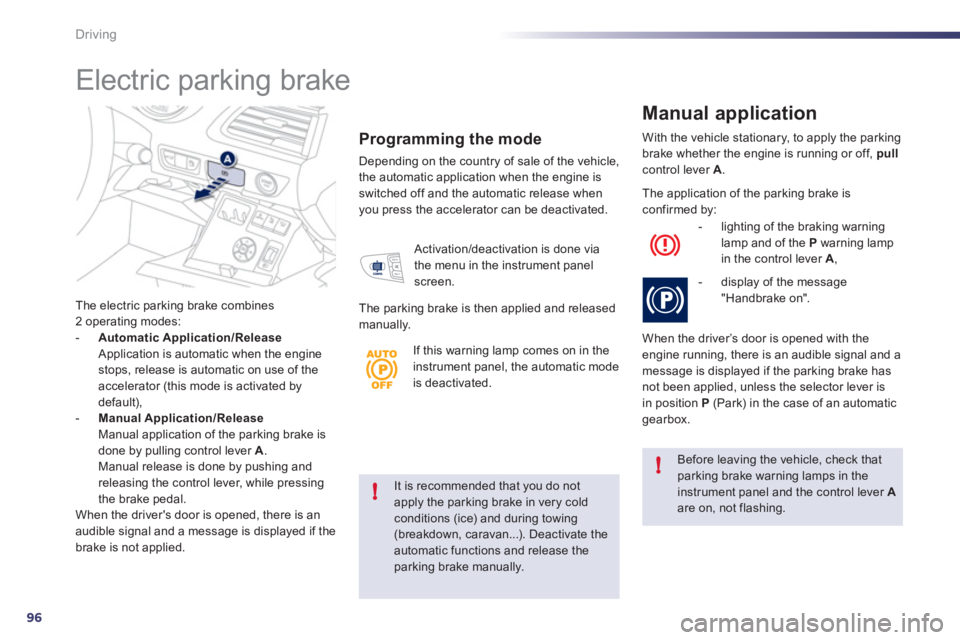
96
!
!
Driving
It is recommended that you do not
apply the parking brake in very cold
conditions (ice) and during towing
(breakdown, caravan...). Deactivate the
automatic functions and release the
parking brake manually.
Before leaving the vehicle, check that
parking brake warning lamps in the
instrument panel and the control lever A
are on, not flashing.
The electric parking brake combines
2 operating modes:
- Automatic Application/Release
Application is automatic when the engine
stops, release is automatic on use of the
accelerator (this mode is activated by
default),
- Manual Application/Release
Manual application of the parking brake is
done by pulling control lever A.
Manual release is done by pushing and
releasing the control lever, while pressing
the brake pedal.
When the driver's door is opened, there is an
audible signal and a message is displayed if the
brake is not applied.
Programming the mode
Depending on the country of sale of the vehicle,
the automatic application when the engine is
switched off and the automatic release when
you press the accelerator can be deactivated. With the vehicle stationary, to apply the parking
brake whether the engine is running or off, pull
control lever A
.
Manual application
Activation/deactivation is done via
the menu in the instrument panel
screen.
The parking brake is then applied and released
manually. The application of the parking brake is
confirmed by:
- lighting of the braking warning
lamp and of the P
warning lamp
in the control lever A
,
- display of the message
"Handbrake on".
When the driver’s door is opened with the
engine running, there is an audible signal and a
message is displayed if the parking brake has
not been applied, unless the selector lever is
in position P
(Park) in the case of an automatic
gearbox.
Electric parking brake
If this warning lamp comes on in the
instrument panel, the automatic mode
is deactivated.